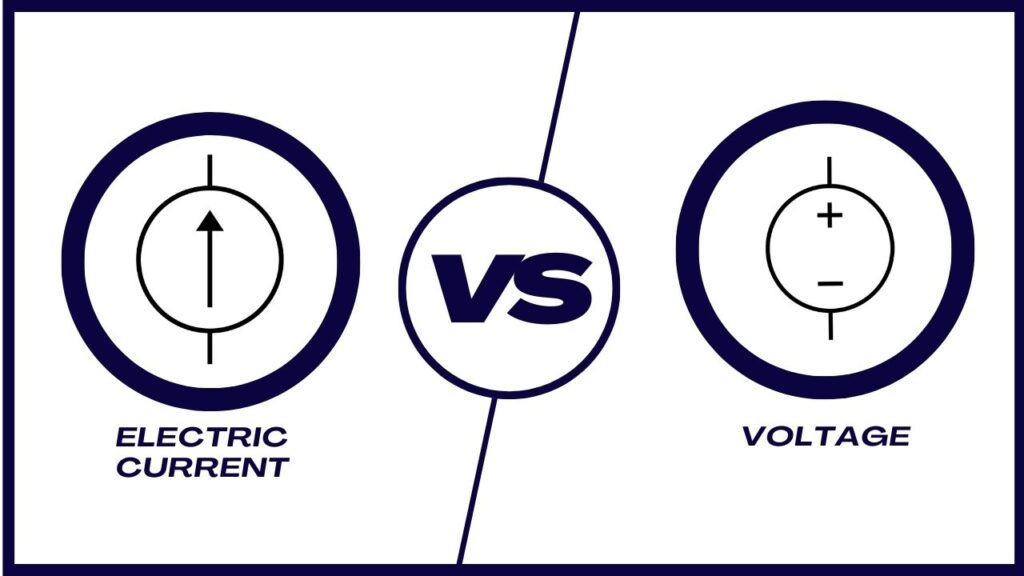The primary difference between current and voltage is that the current is the flow of electric charge carriers in a particular direction, whereas the voltage is an electric pressure that pushes the electric charge carriers through a conductor. In this article, I will explain all the major differences between current and voltage. Before that let us get an overview of electric current and voltage individually.

What is an Electric Current?
The directed flow of electric charge carriers through a conducting medium like a metal wire is known as electric current. It is denoted by the letter I or i. The symbol “I” is used to represent the constant electric current, and the symbol “i” is used to represent the time-varying electric current.
Mathematically, the strength of electric current is measured as the rate of flow of electric charge i.e.
$$I=\frac{Q}{t}$$
Here, Q is the charge in coulombs and t is time in seconds. Hence, the unit of electric current is given by,
$$\text{Unit of }I = \frac{\text{Coulomb}}{\text{Second}}=\text{Ampere}(A)$$
Ampere (A) is the SI unit of electric current.
The strength of electric current through a conducting material is measured by using an instrument named, an ammeter (Ampere-Meter).
The ammeter is connected in the series of the circuit whose electric current is to be measured.
What is Voltage?
Voltage is the electric pressure that pushes the electric charge carriers like electrons through a conducting material. It is also known as potential difference (p.d.).
Voltage is denoted by the letter V or v. Where, the symbol “V” is used to represent a constant voltage, while the symbol “v” is used to represent a time-varying voltage.
Voltage is basically the difference of potentials between two points in an electric circuit. Hence, there is nothing like voltage at a single point.
Mathematically, the strength of voltage is given as the work done per unit charge i.e.
$$V=\frac{W}{Q}$$
Where W is the work done measured in joules and Q is the charge measured in coulombs.
Hence, the unit of voltage is given by,
$$\text{Unit of }V = \frac{\text{Joule}}{\text{Coulomb}}=\text{Volt}(V)$$
Volt is the SI unit of voltage.
In an electric circuit, the voltage is measured by using an instrument named voltmeter. The voltmeter is connected in parallel to the circuit whose voltage is to be measured.
After discussing the current and voltage. Let us discuss the differences between current and voltage.
Difference between Current and Voltage
The major differences between current and voltage are given in the following table:
|
Key |
Current |
Voltage |
| Definition | The directed flow of electric charge carriers through a conducting material is called electric current. | The electric pressure or force that pushes the electric charge carriers through a conducting material is called voltage. |
| Symbol | Current is denoted by the letter “I” or “i”. The symbol “I” is used to denote a constant current and the letter “i” is used to denote a varying current. | Voltage is denoted by the letter “V” or “v”. The symbol “V” is used to represent constant voltage and the symbol “v” is used to represent a varying voltage. |
| Formula | Current is given by,
$$I=\frac{Q}{t}$$ |
Voltage is given by,
$$V=\frac{W}{Q}$$ |
| SI Unit | The SI unit of electric current is Ampere (A). | The SI unit of voltage is Volt (V). |
| Types | Electric current can be classified as direct current (DC) and alternating current (AC). | Voltage can be classified as direct voltage and alternating voltage. |
| Cause & Effect | Electric current flows due to voltage. | The voltage causes an electric current to flow through a circuit. |
| Measuring Instrument | Electric current is measured by using an ammeter. | Voltage is measured by using a voltmeter. |
| Field Created | Electric current creates both an electric field as well magnetic field around the conductor. | Voltage creates only an electric field. |
| In Series Connection | The current remains the same through all circuit elements connected in series. | Voltage is different across each circuit element connected series. |
| In Parallel Connection | In parallel connected elements, the current through each parallel element is different. | In parallel connected elements, the voltage across all the parallel elements is the same. |
Conclusion
In conclusion, electric current is defined as the flow of electric charge carriers through a conducting material in a particular direction, whereas voltage is defined as the work done required to move a unit charge from one to another in an electric field. Both voltage and current are the basic electrical quantities in electric circuits. Hence, it is important to know about their differences.
In this article, I have explained the concept of electric current and voltage and the important difference between current and voltage in tabular form.
If you have any queries related to this topic. Please, let me know in the comment section. I will answer shortly.